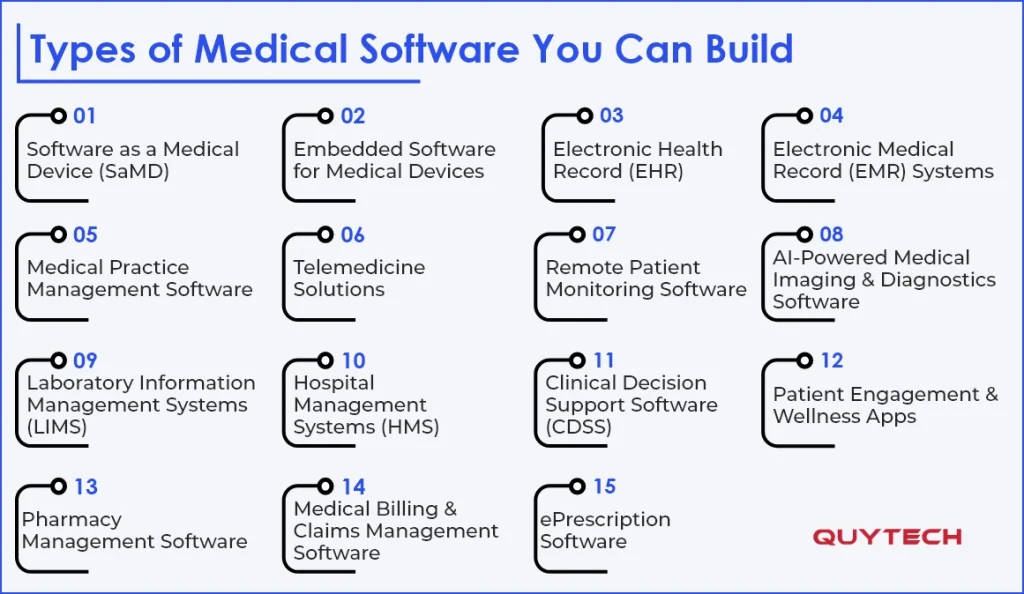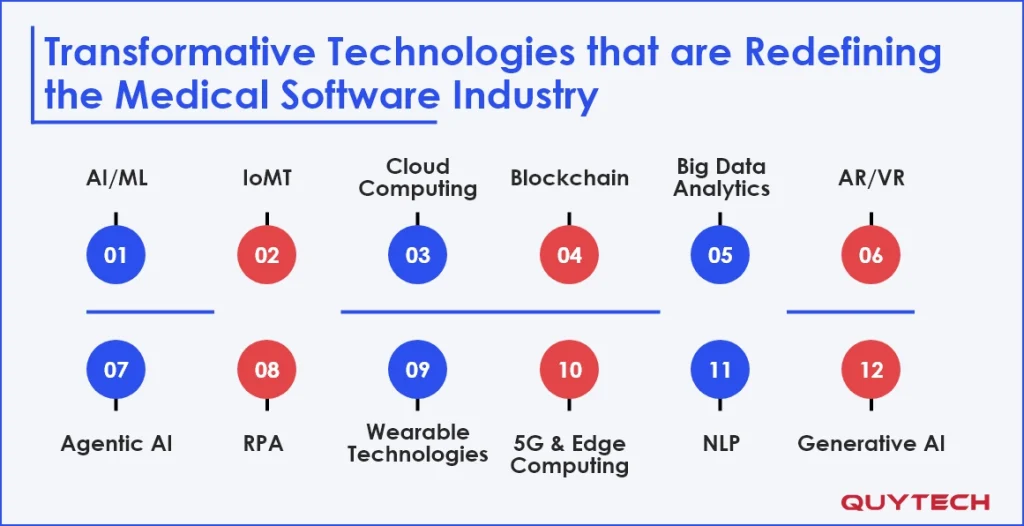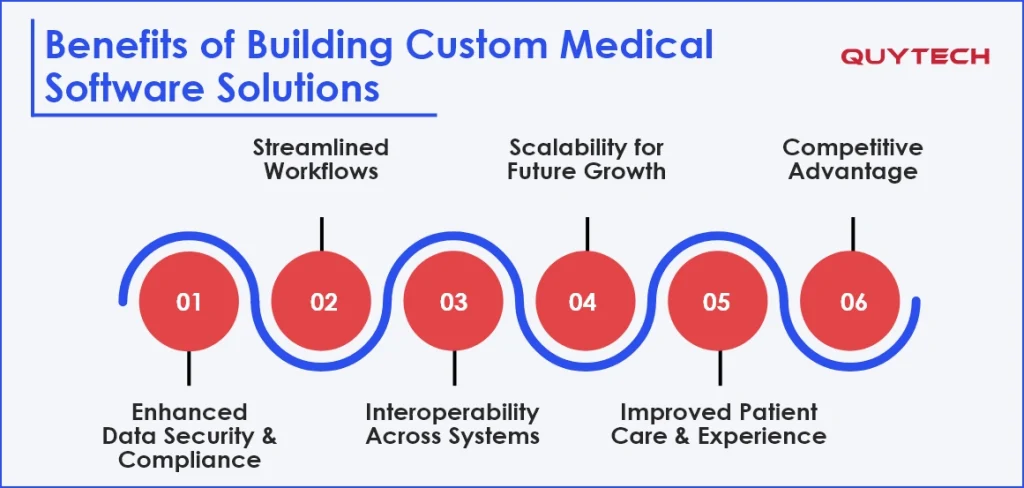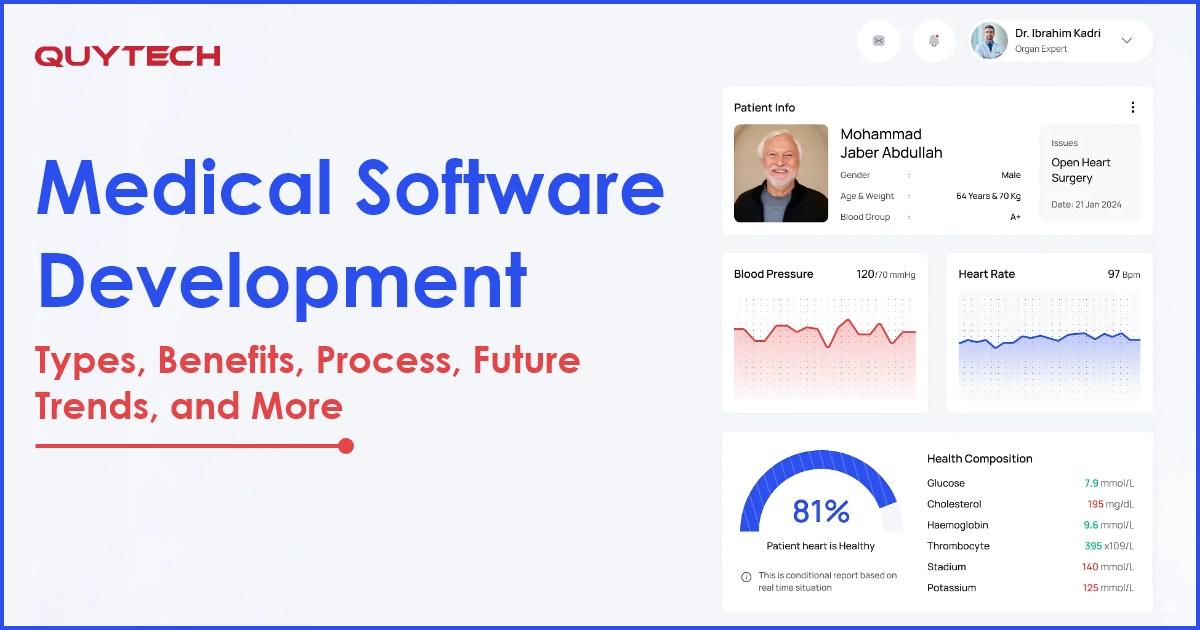With technologies increasingly entering all aspects of the healthcare industry, the demand for medical software is skyrocketing. On one side, medical and healthcare software automates routine operations, and on the other side, they make healthcare services accessible for everyone.
These days, medical software for remote patient monitoring, invoice and billing management, telehealth, and medical imaging and diagnostics are powered by artificial intelligence, machine learning, IoMT, and blockchain-like technologies. The only thing that requires great attention is how to develop medical software.
This detailed medical software development guide will clear all your doubts on the development process, benefits, types, and other aspects of healthcare software solutions. Without any delay, let’s get started:
A Brief About Medical Software Development
The name says it all! Medical software is a digital solution used for diagnosing and monitoring diseases and other purposes, including managing healthcare data and making informed clinical decisions. These are not generic healthcare solutions; they specifically focus on patient safety and improving medical workflows.
Medical software can be an individual entity or integrated within a medical device or equipment, like ECG machines and others. If it operates independently, it is known as Software as a Medical Device or SaMD. Some other examples of medical software are AI-powered diagnostic tools and imaging systems, EHR systems, and clinical decision support systems.
What is Medical Software Development
The process of creating any type of medical software is known as medical software development. It involves designing, developing, testing, deploying, and maintaining. Medical software development requires strictly adhering to regulations and compliance, such as the FDA, MDR, HIPAA, IEC 62304, and others that will be covered later in this blog.
Key Takeaways
- Medical software development is the process of creating safe, effective, and regulatory-ready medical software for diverse uses.
- SaMD, EHR, EMR, LIMS, and HMS are a few popular types of medical software.
- FDA, MDR, HIPAA, and IEC 62304 are some regulations that medical software must adhere to.
- Enhanced data security, streamlined operations, and interoperability are some key benefits of healthcare software.
- Future trends of medical software development include the integration of blockchain, IoMT, AI agents, and other top technologies.
Types of Medical Software You Can Build
To develop medical software, you can choose from the following:

- Software as a Medical Device (SaMD)
SaMD solutions don’t require a physical device to perform medical operations; they are intended to. If you build software as a medical device, you can analyze medical data, get assistance in disease diagnoses, and monitor the conditions of a patient, without actually being present at the patient’s location.
Examples of SaMD are AI-powered diagnostic tools, digital therapeutics, and medical imaging analysis software.
- Embedded Software for Medical Devices
Such medical software can be integrated within medical devices to control their functionality and make sure they offer a real-time response to inputs. Some examples of such medical devices are infusion pumps, pacemakers, and MRI scanners.
- Electronic Health Record (EHR)
EHR or electronic health record software is the most popular software that almost every healthcare organization or medical facility uses. The software stores, manages, and shares detailed patient health data across different systems. This facilitates real-time access to patient information.
Cloud-based EHR platforms, interoperable patient portals, and integrated clinical dashboards are a few examples of EHR solutions.
- Electronic Medical Record (EMR) Systems
Maintaining digital patient records within one organization is the core purpose that an electronic medical record system ensures. With an EMR system, physicians can track patient history, diagnosis, prescriptions, and the progress of the treatment. Some examples include EMR systems for dental, ophthalmology, or cardiology practices.
You may want to read: How to Develop a Patient Record Management System?
- Medical Practice Management Software
MPM software streamlines administrative tasks. You can build such medical software to automate billing, invoicing, appointment scheduling, and reporting operations. This will improve workflow efficiency.
Appointment scheduling systems, revenue cycle management tools, and patient communication portals are some examples of medical practice management software.
- Telemedicine Solutions
Telemedicine platforms facilitate a seamless connection between patients and doctors. It is done by enabling them to conduct virtual consultations via video, message, or document sharing. This enhances healthcare accessibility.
On-demand consultation apps, telepsychiatry platforms, and virtual care management systems are a few examples of telemedicine solutions.
Explore More: The Future of Telehealth- How Will It Reshape the Healthcare Industry?
- Remote Patient Monitoring Software
Remote patient monitoring software relies on IoT-enabled medical devices to collect patient health data and monitor their health. The data could be associated with the patient’s heart, glucose levels, or blood pressure.
Some examples include cardiac monitoring apps, diabetes tracking platforms, and wearable-integrated health systems.
You may like to read: AI in Remote Patient Monitoring: Improving Healthcare Accessibility and Convenience
- AI-Powered Medical Imaging and Diagnostic Software
AI-powered medical imaging and diagnostics software can accelerate the diagnosis of diseases or health problems without compromising accuracy. These software utilize artificial intelligence to analyze medical images, such as X-rays, MRIs, and CT scans, and deliver accurate outputs.
AI-driven radiology platforms, automated pathology detection tools, and predictive analytics systems are some examples of such medical software.
Read More: AI-powered Medical Imaging and Diagnostics: The 2026 Comprehensive Guide
- Laboratory Information Management Systems (LIMS)
As the name suggests, laboratory information management systems or solutions automate operations that are generally performed by human resources in a laboratory. These operations could be sample tracking, result reporting, and preparing compliance documents.
Clinical lab automation systems, pathology data management platforms, and biotech research LIMS are a few examples of LIMS.
- Hospital Management Systems (HMS)
HMS platforms or hospital management systems bring all hospital operations under one roof. Whether you want to do new patient registrations, generate bills, check pharmacy or laboratory data, or manage inventory, one software is sufficient for all this.
A modular HMS platform for multispecialty hospitals is a perfect example of HMS.
- Clinical Decision Support Software (CDSS)
You can plan to build a CDSS that will assist your healthcare professionals with data-driven clinical decision-making. Such medical software analyzes patient data, medical history, and other details to provide recommendations for diagnosis and treatment.
Some examples include drug interaction alerts, diagnostic assistance systems, and treatment pathway recommendations.
- Patient Engagement and Wellness Apps
Patient engagement and wellness apps and software are in high demand. They empower patients to easily communicate with healthcare professionals. Such software also ensures preventive care and healthy habits.
Fitness tracking apps, medication reminder tools, and chronic disease management apps are a few examples you can refer to.
Similar Read: How Mobile Health Apps Improve Patient Engagement
- Pharmacy Management Software
You can plan to build a pharmacy management software that enables pharmacists to seamlessly manage daily tasks. They can manage prescriptions, track drug inventory, and automate billing.
A few examples of such software include automated dispensing systems, inventory tracking software, and drug interaction checkers.
- Medical Billing and Claims Management Software
Medical billing and claims management software are very common medical software that healthcare organizations and medical facilities use to simplify financial operations. The finance teams in medical facilities can automate billing, insurance verification, and other tasks like claims submissions and processing.
Examples of such medical software are claims tracking systems, payment processing tools, and revenue cycle management platforms.
- ePrescription Software
ePrescription medical software is one of the popular types of medical software that is in high demand. Such software creates and sends prescriptions to pharmacies to avoid any errors that generally happen due to a misunderstanding of what is written on the prescription.
Read Similar: How to Develop a Prescription Discount App like GoodRX?
Technology Stack Required for Medical Software Development
To develop medical software of any type, it is required to carefully select its technology stack. You can choose from the following technologies:
| Layer / Category | Technologies / Tools |
| Frontend (UI/UX) | React, Angular, Vue.js, HTML5, CSS3, TypeScript |
| Backend | Node.js, Python (Django/Flask), Java (Spring Boot), .NET Core, Ruby on Rails |
| Mobile App Development | Swift (iOS), Kotlin (Android), Flutter, React Native |
| Database | PostgreSQL, MySQL, MongoDB, MS SQL Server, Oracle |
| Cloud Platforms | AWS, Microsoft Azure, Google Cloud |
| AI/ML & Analytics | TensorFlow, PyTorch, Scikit-learn, OpenCV, Power BI, Tableau |
| DevOps & CI/CD | Docker, Kubernetes, Jenkins, GitLab CI, Terraform |
| Security & Compliance Tools | OAuth 2.0, SSL/TLS, JWT, Firewalls, AWS Shield |
Steps to Develop Software for the Medical Industry
Medical software development requires following a stepwise process, which is as follows:
Step 1: Requirement Analysis and Feasibility Study
The first step is to understand your medical software development needs. In other words, define its purpose, use case, and compliance requirements. Conduct a feasibility study to evaluate both technical and financial aspects. Also, check what regulatory requirements you need to fulfill to build your software. Define the technology stack required for building the particular type of medical software.
Step 2: UI/UX Design
For any medical software, it is imperative to have a user-centric design for seamless accessibility and ease of use. You can try building a prototype first to validate workflows and review user journeys. Once done, prepare the architecture design using the decided tech stack and technologies like AI, IoMT, and cloud. Make sure the architecture supports interoperability.
Step 3: Develop and Test
Now create the medical software’s backend and frontend. Consider the usability and performance as key performance indicators. Thoroughly test (unit, integration, performance, and usability) each aspect of the software to build a way for its success.
Step 4: Validation, Verification, and Clinical Evaluation
Medical software needs to be thoroughly validated by medical professionals to verify that it serves its defined purpose and works well in real-world scenarios. Don’t forget to conduct this evaluation. Get regulatory approvals and submit required documents for approval by regulatory authorities as per your country or region.
Step 5: Deployment and Integration
Once everything is done, proceed to the deployment of the software within the hospital, clinic, or cloud environments. You may also need to integrate it with EHR, billing, or any other hospital management system. While doing so, pay attention to the software’s interoperability and data integrity.
Step 6: Post-Launch Maintenance
Continuously monitor the performance of the software and also consider user feedback to make necessary changes. Regularly update the software with new features and fix bugs as soon as they occur and are detected.
Dive Deeper: Step-by-Step Guide for Healthcare Software Development
Transformative Technologies that are Redefining the Medical Software Industry
The top technologies that transform the way medical software works or functions are as follows:

AI and ML
AI and ML are used in medical software development to:
- Empower diagnostic accuracy
- Offer predictive insights
- Deliver personalized treatment recommendations
Continue Reading: Top Use Cases and Benefits of AI in Healthcare
Internet of Medical Things (IoMT)
IoMT is used in medical software development to:
- Connect medical software with wearables
- Remotely monitor devices and patients
- Monitoring hospital equipment
Cloud Computing
Cloud computing is used in medical software development to:
- Ensure secure and scalable data storage
- Seamless accessibility of the software
- Make sure interoperability between different healthcare systems
Blockchain
Blockchain is used in medical software development to:
- Enhance security
- Improve transparency
- Ensure immutability in patient data management and sharing
Big Data Analytics
Big data analytics is used in medical software development to:
- Extract insights from clinical and operational data
- Improve patient outcomes
Similar Read: AI in Healthcare Data Analytics: Cutting Readmission Rates
AR&VR
Augmented reality and virtual reality are used in medical software development to:
- Support medical training
- Deliver interactive experiences
Explore More: How AR/VR technologies can be a breakthrough in Healthcare Sector
Agentic AI
Agentic AI is used in medical software development to:
- Clinical decision support
- Automated workflow coordination
RPA
Robotic process automation is used in medical software development to:
- Streamlining repetitive administrative processes
- Improve operational efficiency
Wearable Technology
Wearable technology is used in medical software development to:
- Ensure continuous health monitoring
- Early disease detection
- Deliver insights through connected devices
Discover More: Wearables For Mhealth Apps: The Future Of The Healthcare Industry
5G and Edge Computing
5G and edge computing technologies play a vital role in medical software development by:
- Powering low-latency telemedicine consultations
- Ensuring real-time imaging with high-speed data transmission
Generative AI
GenAI is used in medical software development to:
- Accelerate drug discovery
- Automate clinical documentation
Read More: Generative AI in the Pharmaceutical Industry: Use Cases, Benefits & Future
NLP
Natural language processing is used in medical software development to:
- Automate medical transcription
- Improve EHR documentation
- Facilitate conversational AI for patient engagement
You may want to read:
Regulatory Compliance & Standards Need to Develop Medical Software
For medical software development, you cannot afford to ignore or skip adhering to regulatory compliance and standards. These are the most common standards required for medical software development.
| Region / Country | Key Regulatory Bodies | Relevant Standards / Guidelines |
| United States (USA) | FDA (Food and Drug Administration) | FDA 21 CFR Part 820, FDA 510(k), FDA SaMD Guidance, HIPAA (Health Insurance Portability and Accountability Act) |
| Europe (EU) | European Medicines Agency (EMA), European Commission | EU MDR (Medical Device Regulation) 2017/745, GDPR (General Data Protection Regulation), ISO 13485, IEC 62304 |
| India | Central Drugs Standard Control Organization (CDSCO) | Medical Device Rules (MDR) 2017, Digital Information Security in Healthcare Act (DISHA – proposed), ISO 13485 |
| Canada | Health Canada | Medical Device Rules (MDR) 2017, Digital Information Security in Healthcare Act (DISHA – proposed), ISO 13485 |
| United Kingdom (UK) | Medicines and Healthcare products Regulatory Agency (MHRA) | UK MDR 2002 (as amended), UKCA Marking, GDPR (UK version) |
Please note that the regulatory standards keep updating or changing from time to time. Therefore, it is recommended to check them before you begin developing medical software.
Benefits of Building Custom Medical Software Solutions
When you invest in software development for the medical industry, you can streamline workflows, enhance data security and compliance, ensure interoperability, and improve patient care. Let’s understand how:

- Streamlined Workflows
Custom medical software solutions can streamline workflows and automate critical clinical documentation, administrative tasks, and operational processes. This reduces manual resource dependency.
- Enhanced Data Security & Compliance
Medical software, built with compliance-first architecture, complies with HIPAA, GDPR, MDR, and ISO 13485, takes security to the next level, and builds transparency and trust with patients. The software also ensures automated compliance with defined industry standards and regulations.
- Interoperability Across Systems
Medical software, developed by an experienced healthcare app development company, can be easily integrated into EHRs, IoMT devices, CRMs, and other healthcare management systems. This ensures seamless interoperability and data exchange for a unified ecosystem.
- Scalability for Future Growth
Custom medical software solutions development, when done by expert hands, makes sure the solution can be scaled to accommodate new users, devices, and workload without compromising performance.
- Improved Patient Care & Experience
Medical software solutions and applications automate time-intensive routine tasks to enable medical professionals to focus on patient care and improving patient experience. Such software enhances the accuracy of diagnosis and treatment results.
- Competitive Advantage
Healthcare organizations that implement medical software can get a competitive edge by utilizing the power of AI and other technologies for accurate disease diagnosis, predictive analytics, and remote patient monitoring.
You may be interested in: How Predictive Analytics is Transforming the Healthcare Industry

Challenges You May Encounter While Developing Medical Software
Medical software development is not as easy as it seems. There are several challenges that you may encounter. The section highlights all those possible roadblocks and also provides you with the best possible solution to overcome them.
- Inability to Adhere to Strict Regulatory and Compliance Requirements
It is imperative for medical software, especially those used for diagnostics, treatment, and disease prevention, to comply with standards and regulatory requirements (could be international or of that specific country). Not complying with these requirements can result in penalties.
Follow a compliance-by-design approach during medical software development. This means you have to integrate regulatory requirements during the development only.
- Lack of Data Security and Patient Privacy
Medical software and mobile applications deal with highly sensitive patient information. Not implementing top-notch security practices may compromise this information or put it at risk of a data breach.
Implement robust data security and encryption techniques, adopt a zero-trust architecture, and conduct regular security audits to overcome this challenge.
Continue Reading: The Importance of Data Privacy and Security in Healthcare Apps
- Inability to Integrate with Legacy System
Medical software needs to be integrated with existing infrastructure, such as EHRs, LIMS, or HMS, and systems for seamless data exchange. This could be a challenge in the successful development of medical solutions.
To overcome this challenge, implement standardized healthcare data protocols like HL7 and FHIR.
- Not Ensuring Data Accuracy and Real-Time Processing
Inability to ensure data accuracy may become an obstacle for the AI-powered diagnostics systems and other medical software solutions to deliver accurate output.
Integrate real-time data analytics and validation mechanisms to make sure the data is accurate and synchronized in real-time.
- High Development and Maintenance Cost
This could be a challenge for some healthcare organizations or individual healthcare service providers. By cost, we mean the money spent on ensuring compliance documentation and clinical validation.
To overcome this, opt for agile and modular development.
Future Trends in Medical Software Development
Now that you know almost everything about medical software development, let’ explore future trends which incline towards data-driven and patient-centric care. In other words, let’s understand the future of custom medical software solutions in 2026 and beyond:
- AI-Driven Predictive Healthcare
Artificial intelligence has already become a critical part of the healthcare world. In 2026 and the upcoming years, we may see the use of AI and ML in diagnostic software, invoicing and billing management, and other medical solutions. This will accelerate diagnosis, enhance accuracy, streamline operations, and minimize medical management costs.
Take a look at: Health Risk Assessment Using AI/ML
- Widespread Adoption of Generative AI
Another trend in software development for the medical industry is the integration of generative AI to streamline clinical documentation, automate report generation, and help in drug discovery. The technology will help healthcare organizations improve operational efficiency and minimize dependency on manual resources.
Explore More: Exploring the Power of Generative AI in Drug Discovery
- Integration of Internet of Medical Things (IoMT)
IoMT can be integrated into wearables, smart monitors, and connected implants to ensure continuous health monitoring. The technology can also provide real-time critical insights that enable medical professionals to adopt a proactive approach.
Read in detail: How IoMT is Revolutionizing Patient Care and Hospital Efficiency
- Cloud-Native and Interoperable Platforms
In 2026 and beyond, we may witness an increase in the number of cloud-powered medical software that can be accessed from anywhere and scaled without any difficulty. Such software would also ensure data interoperability across other hospital management and patient management solutions.
- Personalized and Precision Medicine Software
AI, in combination with genomic data integration, is all set to transform medical software development. These technologies will ensure personalized care plans and treatments considering the patient’s genetic and lifestyle factors.
- Integration of Blockchain for Data Security and Transparency
In the upcoming years, we may also see increasing adoption of blockchain in securing patient data and ensuring immutable medical records. The technology will also help in maintaining transparency in clinical trials.
You may want to explore: How Blockchain Being Used in Healthcare: Use Cases, Benefits
- Voice and Conversational AI Assistants
In 2026 and the upcoming years, we may see voice-driven interfaces in medical software. Chatbots will also become a critical feature of almost every custom medical software solution. This will assist clinicians in automating documentation and appointment management to reduce workload.
Unlock the insights: How to Develop an AI Virtual Health Assistant- Step-by-Step Guide
- 5G and Edge Computing Integration
Medical software with 5G and edge computing capabilities will enable ultra-fast data processing for telemedicine. This will also help in remote surgeries and ensure seamless connectivity in medical software and devices.
- Reliance on RegTech
Compliance adherence is critical for almost every medical software. In the future, we may see the implementation of regulatory tech for compliance automation. The technology will simplify documentation and automate monitoring of compliance adherence.
Building a Secure and Scalable Medical Software with Quytech
Quytech is a trusted healthcare app development company that builds secure, compliant, and future-proof medical software. We have dedicated AI, IoMT, cloud, and blockchain experts who are conversant with HIPAA, GDPR, MDR, and FDA standards.
Their tech expertise and proven background of building telehealth solutions, healthcare CRMs, AI-powered diagnostics systems, and other medical software assures client that their software will meet their exact requirements and expectations.
Some of the notable healthcare and medical software solutions that Quytech has successfully delivered are:
- AI-powered application for orthopedic patients
- AI-driven meditation app
- AI-enabled patent research software
- Fitness and wellness app powered by artificial intelligence
If you have your project requirements ready, connect with our experts now!
Final Thoughts
Medical software development using top technologies like AI, ML, IoMT, and blockchain can be used for various use cases, including remote patient monitoring, healthcare operations management, improving diagnostic accuracy, accelerating drug discovery, and others.
Software development in medical requires partnering with a reliable and highly experienced technology partner who can understand your requirements and build a secure and compliant medical software that aligns with your goals and serves its expected purpose.
But before you find a partner, read this blog to explore the benefits, regulatory requirements, technology stack, future trends, and other crucial information about custom medical software solutions development. If you want to build one on your own, the blog also provides you with a step-by-step development process.
FAQs Associated with Medical Software Development
The cost of building medical software depends on the type of software, its complexity, features to be integrated, technology stack, compliance requirements, third-party integrations, and a number of other factors. Share your requirements with Quytech’s experts for an accurate cost estimation.
Medical apps and software that are used to diagnose, treat, or prevent diseases need approval from the FDA. Medical software developed for appointment booking/scheduling or general wellness doesn’t require FDA approval.
Software development for medical requires six to twelve months. The time greatly depends on the complexity, regulatory approval processes, and various other factors.
Each medical software has different features, such as EHR integration, automated operation (billing, invoicing, and others), and secure data management.
Consider the following points while choosing the best medical software development company:
– Expertise in AI, ML, Agentic AI, Gen AI, Blockchain, IoMT, and others
– Commitment to data security and privacy
– Prior experience in building medical software
– Knowledge of compliance, like HIPAA, FDA, and others
– Experience in developing native, cross-platform, and cloud-powered medical software and apps.


